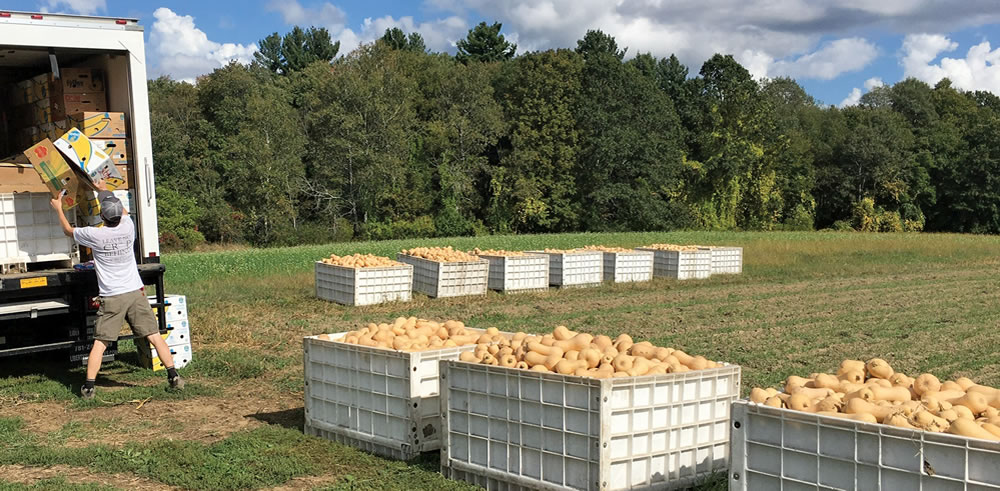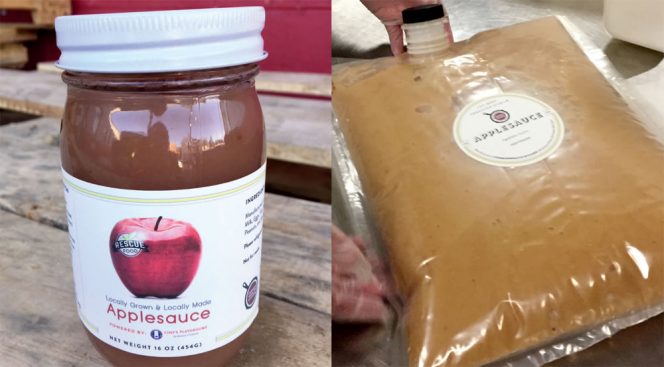Professionally managed gleaning and value-added processing of gleaned harvests are contributing to enterprise creation and reducing the amount of food loss on farms. Part II
Marsha W. Johnston
BioCycle March/April 2018

Boston Area Gleaners worked with The Food Project in Lincoln (MA) to glean butternut squash. Photo courtesy of Boston Area Gleaners
Facilitating the harvesting and marketing of produce left on fields is the foundation of a number of new enterprises, both nonprofits and for profit companies, and can also involve value-added processing, such as making applesauce and salsa. Part II of this article continues profiling participants on a November webinar organized by Salvation Farms in Morristown, Vermont and hosted by the Harvard University Food Law and Policy Clinic as part of its Food Recovery Entrepreneur Workshop Steering Committee. Part I featured Salvation Farms and Vermont Commodity, and Bon Appétit Management Co. (“Innovating To Reduce Wasted Food Left On Farms,” February 2018). Part II includes Boston Area Gleaners and Hungry Harvest, with a sidebar on CommonWealth Kitchen.
Boston Area Gleaners
Boston Area Gleaners (BAG) in Boston, Massachusetts, began in 2004 as a grassroots farm-to-pantry gleaning organization. Laurie “Duck” Caldwell, Executive Director, who was BAG’s first employee in 2010, gradually transformed BAG from a simple rescue operation into a professionally managed service to farms. Its three services are: field gleaning for donation; storage of late-season gleaned produce; and a pickup service to farms offered on an “as requested” or scheduled basis.
BAG works with over 50 farmers in eastern Massachusetts. “We try to stay within an hour’s distance of Boston to make the trips feasible for our volunteers, as well as to maintain a low carbon footprint,” notes Caldwell. “In our relationships with farmers, we began to frame gleaning not as an opportunity to focus on food waste but as an opportunity for farmers to increase donations at no cost. Gleaning became a professionally managed service to farms, even though rescue is still in our mission statement.”
One of BAG’s challenges as a nonprofit, she adds, “is that we are constantly looking for ways to increase our earned revenue. There is so much potential in what we do and being dependent on the traditional nonprofit revenue structure is very challenging and constraining.” She recounted three recent pilot projects aimed at doing that.
In 2016, BAG engaged a large farm with 10 acres of heirloom tomatoes that was looking to produce a value-added product through processing. BAG offered to glean, sort and transport the tomatoes to CommonWealth Kitchen (CWK, see sidebar), a nonprofit food business incubator and food processor located in the Dorchester neighborhood of Boston. CWK processed the tomatoes into a mix of simple, shelf stable jars of diced tomato and into fully-prepared jars of marinara. About half of the product was purchased by the farmer and sold at its farmstand and CSA. The balance was distributed by BAG to its network of food pantries, providing simple, locally-sourced, nutritious products to food insecure families in the winter. The farmer paid BAG to do the gleaning and manage the process with CWK, and paid CWK for the processing work.
Through this approach, BAG received revenue from the product, as did the farmer, turning surplus into a new source of revenue. CWK and BAG recently collaborated on another project, procuring surplus apples that were made into applesauce and sold to Boston Children’s Hospital and the Boston Public Schools.
The second pilot involved a small family orchard that was a BAG donor for many years. Following the death of the owner, the farm fell into a multiple sibling inheritance dispute, which resulted in it being only minimally managed and under threat as a farm entity. “We noticed an increase in food loss in the orchard,” says Caldwell. “We also needed a way to respond to large group requests, e.g., corporate service days, to grow our volunteer base and achieve higher gleaning goals that we set for the next three years.” BAG offered to pay the family a fee for access to the land and equipment, including cold storage, in exchange for 100 percent crop donation. This arrangement enabled BAG to take large groups of gleaning volunteers to the orchard, which provided a more continuous stream of apples to the Greater Boston Food Bank.
“Food loss at the orchard was minimized by a large percentage, and the only part of the crop that was lost was due to weather,” she adds. BAG has structured the pilot as a lease arrangement for 2018, under which BAG will own the product and have greater flexibility than before in distributing to institutions. Another nonprofit community farm may join the pilot as well.
A third pilot leverages BAG’s infrastructure to provide trucking for farms. “We now have large refrigerator trucks moving around eastern Massachusetts,” notes Caldwell. “We’re working with over 50 farms and there are opportunities for more backhauling to our central headquarters just west of Boston.” The organization now has capacity to handle pallets and has a new forklift. “As our relationships with farms have deepened, our staff have led them to sales opportunities that would have remained unrealized, linking known supply to known demand,” she adds.
BAG kicked off a new collaboration with MIT Sloane School of Management called the Boston Area Food Hub Project, which aims to research opportunities in the region for aggregating surplus product to create unrealized market opportunities for farmers in eastern Massachusetts. It will also examine innovative ways to procure and distribute surplus that allow BAG to “break out of” the traditional charitable food system model where all product is donated without charge. “There is tremendous potential for new economic development around this, and I feel like the awareness is growing,” says Caldwell. “Collectively, the total potential network is over 500 agencies.”
Hungry Harvest

Hungry Harvest sources cosmetically imperfect produce from farms and wholesalers which it packages in boxes and sells to customers via a subscription service. Photo courtesy of Hungry Harvest
As reported in BioCycle February 2016, “Imperfect Produce Spawns Business Start-Ups,”, Hungry Harvest (HH) began as a student project at the University of Maryland in 2014 to create a market for “ugly” (cosmetically imperfect) produce. Customers subscribe to a service that recovers food from farms and wholesalers due to logistical inefficiencies and cosmetically imperfect produce, and then delivers boxes of the produce to its subscribers. HH started with a network of 50 to 60 farms and wholesalers, from all over the East Coast, mainly in Pennsylvania and Maryland. Now established from New York to south Florida, the company has recovered 6 million pounds of food since it began in 2014, and has a “very aggressive expansion plan to be reaching more people,” says Stacy Carroll, sales and partnership director.
HH sources produce from local small farmers when available, but mostly from national large-scale growers, wholesalers, and distributors. “We do not want to compete with farmers markets,” Carroll adds, “but to [serve] people who only eat fruits and vegetables from a grocery store. We deliver boxes of this produce for 20 percent less than a grocery.”
At its hub in Baltimore Terminal Market, HH set up a new operations system in November, establishing total control over its packing. “Before we worked with a copacker, but now we can really control how long we hold onto things,” she explains. “We don’t want to hold onto things very long [because] a lot of the food we’re getting is ripe now. We also have systems that optimize our logistics routes to make sure we don’t waste gas or time. For us, it’s about reducing waste in every piece of the process.”
The goal is to purchase only as much produce as it projects it will use in a week. “When we are running our production, we have a very small margin for error,” adds Carroll. Any excess may go to supplying produce in SNAP [Supplemental Nutrition Assistance Program] markets, where HH’s sister company, Produce In A SNAP, sets up farmers market-style outlets in low income and food desert neighborhoods. Anything left over after that is diverted to composting. The company also has secondary markets for the produce it procures. For example, it supplies Misfit Juicery, based in Washington, D.C., which uses ugly fruits and vegetables and post production scraps from fruit and vegetable processors to make cold-pressed juices.
Marsha W. Johnston, an editor with Earth Steward Associates, is a Contributing Editor to BioCycle.












